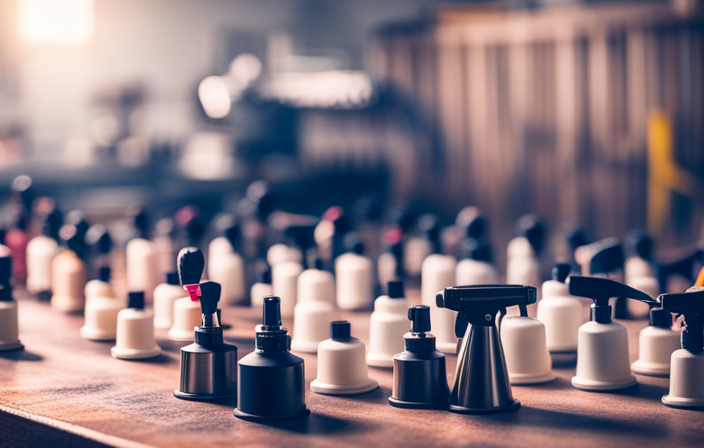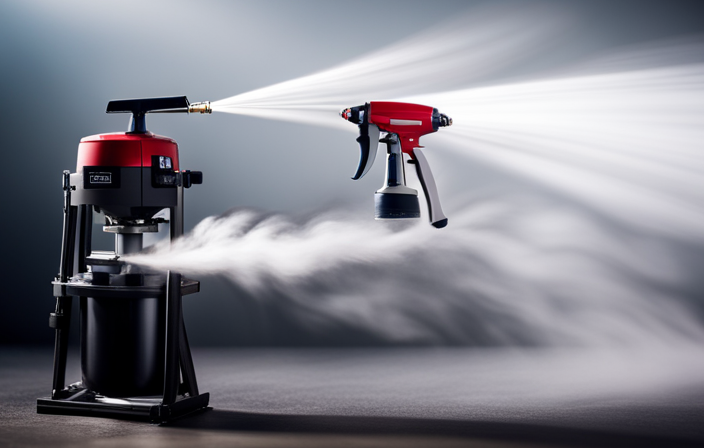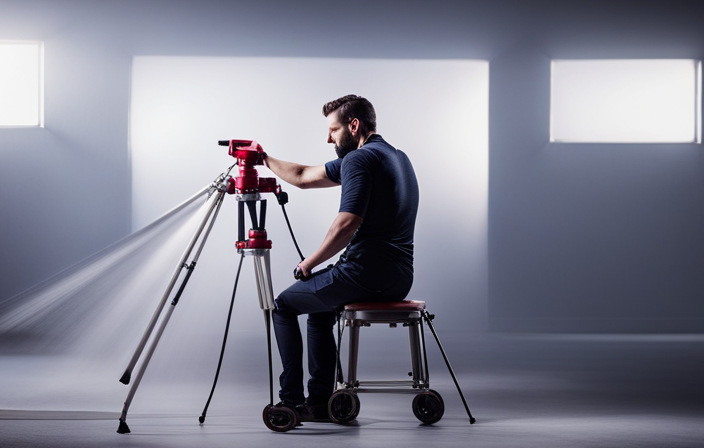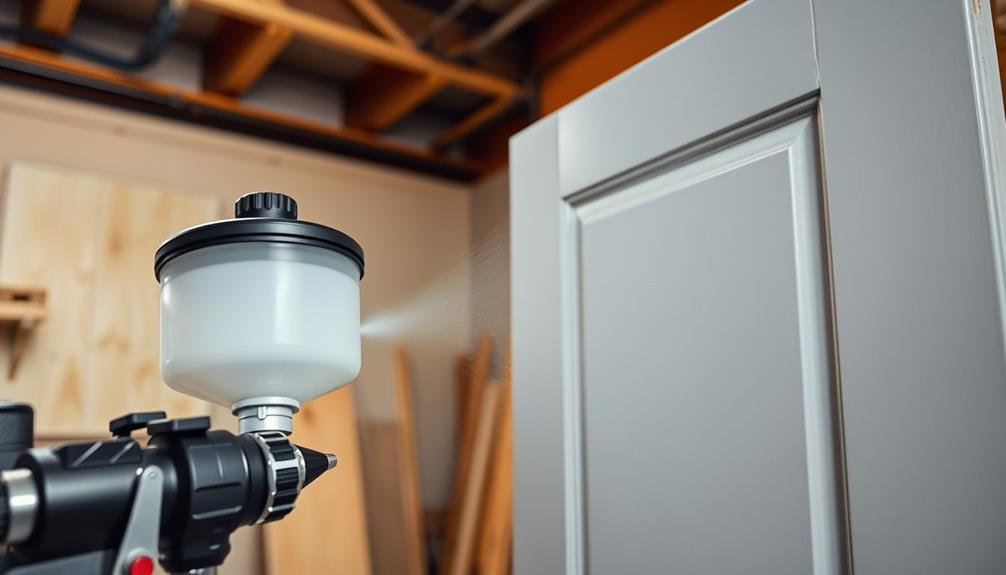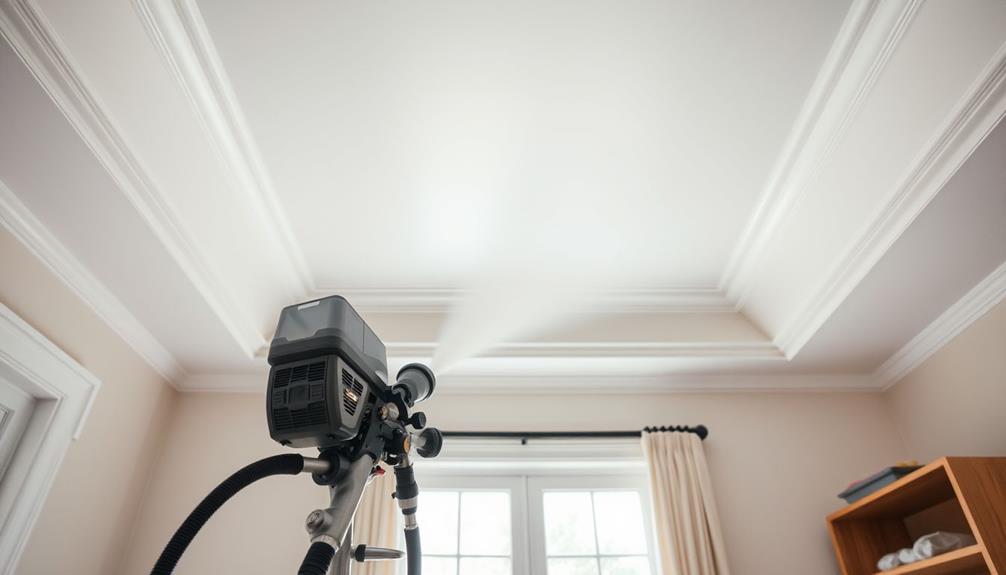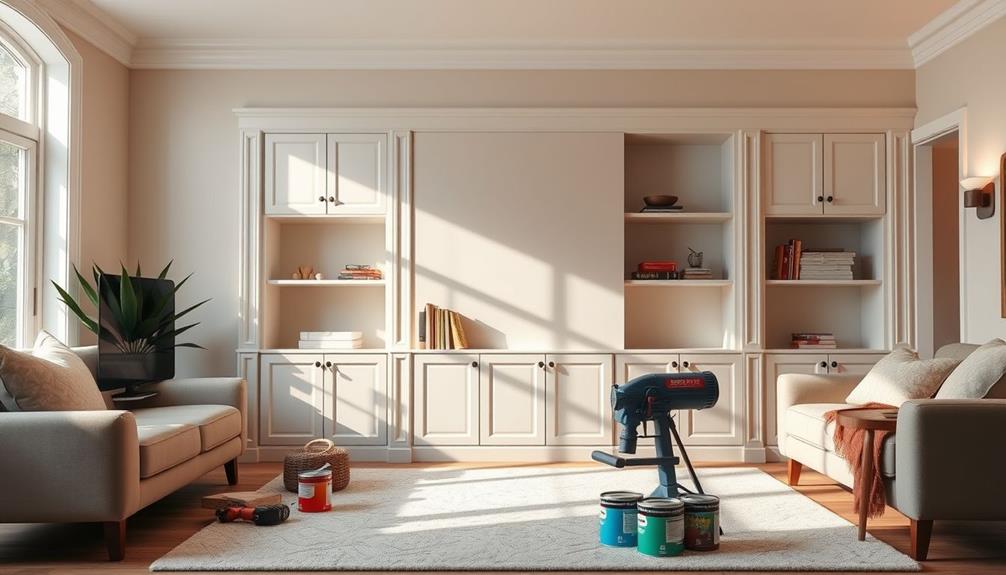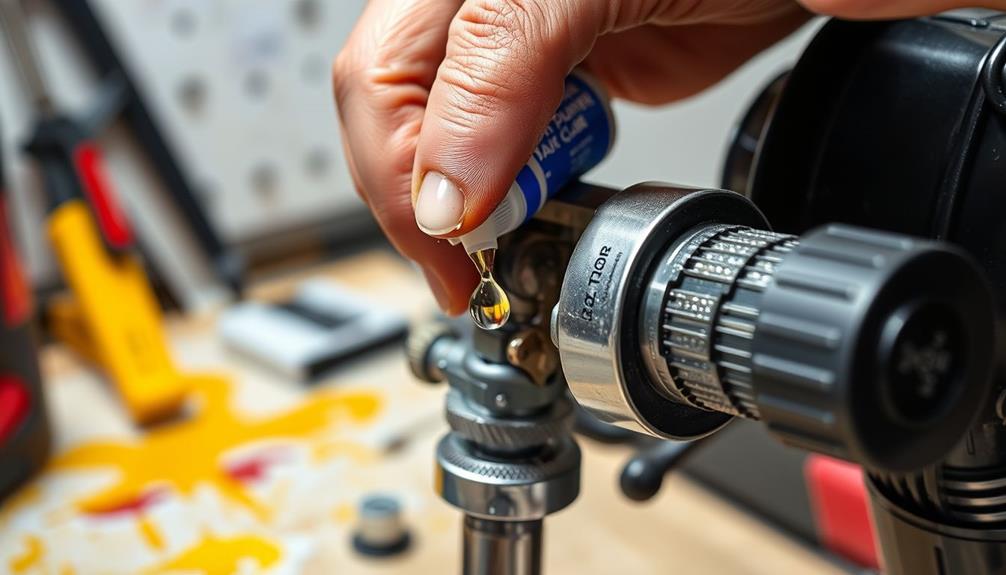As I get ready to confront a blank canvas and unleash my creative expression, I am presented with a crucial decision: which kind of paint sprayer should I choose? Should I stick with the dependable compressed air paint sprayer, or should I think about the state-of-the-art airless paint sprayer? This article is designed to delve into the specifics of both paint sprayer types, providing you with the insights needed to make an informed choice.
With a compressed air paint sprayer, the process is akin to a gentle breeze caressing the surface of your artwork. The compressed air propels the paint, creating a fine mist that effortlessly glides onto the canvas.
On the other hand, the airless paint sprayer is like a powerful torrent, delivering a high-pressure stream of paint with precision and speed.
Join me as we explore the pros and cons of each option, delve into the factors to consider when choosing a paint sprayer, and compare their performance. By the end, you’ll have the confidence to select the perfect paint sprayer for your specific needs.
Let’s embark on this artistic journey together.
Key Takeaways
- Compressed air paint sprayers are suitable for achieving a smooth and even finish, but they may result in more overspray.
- Airless paint sprayers provide a smooth and even finish on various surfaces, reduce overspray, and save time and paint.
- Compressed air paint sprayers require a compressor, adding to the overall cost and making them less portable.
- Airless paint sprayers are more efficient and convenient for professional-quality results, making them ideal for large exterior painting projects.
Understanding the Basics of Compressed Air Paint Sprayers
Understanding the basics of compressed air paint sprayers is essential before diving into the world of painting. These tools are like magical wands that effortlessly coat surfaces with a fine mist of paint. They excel at achieving a smooth and even finish by atomizing paint particles into a flawless mist. This makes them suitable for a wide range of materials, from wood to metal.
However, there are a few important considerations to keep in mind when using compressed air paint sprayers. Firstly, they require a compressor to operate, which can be noisy and bulky. This means that you’ll need to have the necessary equipment and space to accommodate the compressor. Additionally, overspray can be a challenge with these sprayers, requiring careful masking and protection of surrounding surfaces to avoid unwanted paint on unintended areas.
In summary, compressed air paint sprayers offer many benefits, including their ability to achieve a smooth and even finish. However, they also come with some drawbacks, such as the need for a compressor and the potential for overspray. By carefully weighing the pros and cons, you can make an informed decision about whether a compressed air paint sprayer is the right tool for your painting needs.
Pros and Cons of Using a Compressed Air Paint Sprayer
When considering the pros and cons of a compressed air paint sprayer, it’s like trying to compare a gentle breeze to a powerful gust of wind.
Compressed air paint sprayers have their advantages, such as providing a smooth and even finish on various surfaces. They are also versatile, allowing for adjustment of the spray pattern and paint flow, which is beneficial when working on different projects. Additionally, compressed air sprayers are typically more affordable and easier to clean compared to airless sprayers.
However, there are disadvantages to consider as well. These sprayers tend to produce more overspray, which can lead to wasted paint and a messier workspace. They also require a compressor, adding to the overall cost and making them less portable.
Despite these drawbacks, exploring the advantages of airless paint sprayers reveals a whole new level of efficiency and convenience.
Exploring the Advantages of Airless Paint Sprayers
Discover the incredible efficiency and convenience that airless paint sprayers offer, allowing you to effortlessly achieve professional-quality results.
One of the major advantages of airless paint sprayers is their ability to provide a smooth and even finish on various surfaces, including walls, ceilings, and furniture. Unlike compressed air sprayers, airless sprayers use a high-pressure pump to atomize the paint, resulting in a fine mist that evenly coats the surface.
This eliminates the need for multiple coats and reduces overspray, saving both time and paint. Additionally, airless sprayers can handle a wide range of paint materials, from thin stains to thick latex, making them versatile for different projects.
On the downside, airless sprayers can be more expensive and require more maintenance compared to compressed air sprayers. However, the benefits in terms of efficiency and quality make them a worthwhile investment.
Transitioning to the next section, it is important to consider certain factors when choosing an airless paint sprayer.
Factors to Consider When Choosing an Airless Paint Sprayer
When choosing the perfect airless paint sprayer for your next project, it is important to consider several key factors. These factors include the power and pressure capabilities of the sprayer, as they will determine the speed and quality of your paint application. Additionally, you should ensure that the sprayer is compatible with a range of tip sizes, as this will allow you to achieve different paint finishes and cover a variety of surfaces. Durability and reliability are also important factors to consider, so look for a sprayer that is built to last and can withstand heavy use. Checking customer reviews and ratings can help gauge the reliability of the product. Lastly, consider the ease of use and cleanup of the sprayer. Look for features such as adjustable settings, ergonomic design, and easy cleanup to ensure a user-friendly experience. By carefully considering these factors, you can make an informed decision when selecting an airless paint sprayer.
Now, let’s compare the performance of compressed air and airless paint sprayers.
Comparing the Performance of Compressed Air and Airless Paint Sprayers
When comparing the performance of compressed air and airless paint sprayers, it is important to consider both their strengths and weaknesses.
Compressed air sprayers are known for their ability to provide a fine finish, making them ideal for intricate and detailed work. They are often used in applications where a high level of precision is required, such as automotive painting or furniture refinishing. The compressed air allows for a smooth and even application of paint, resulting in a professional-looking finish.
However, compressed air sprayers may not be as effective when it comes to covering large surface areas. The force of the compressed air can sometimes blow away some of the paint before it reaches the surface, leading to uneven coverage. This can be particularly problematic when painting large walls or ceilings, as it may require multiple coats to achieve the desired result.
On the other hand, airless paint sprayers are highly effective for covering large areas quickly and efficiently. They use a high-pressure pump to force the paint through a small opening, creating a fine mist that evenly coats the surface. This makes airless sprayers ideal for exterior painting projects, such as painting a house or a fence.
While airless sprayers excel at covering large areas, they may not provide the same level of precision as compressed air sprayers. The spray pattern can be wider and less controlled, which may not be suitable for detailed work.
In conclusion, understanding your painting needs and project requirements is crucial in determining which type of sprayer is best suited for your specific task. Compressed air sprayers are great for intricate and detailed work, while airless sprayers are highly efficient for covering large areas quickly. By considering the strengths and weaknesses of each type, you can make an informed decision and achieve the desired results in your painting projects.
Understanding Your Painting Needs and Project Requirements
Understanding your painting needs and project requirements is crucial in determining the most suitable sprayer for your specific task. When choosing the right paint sprayer for different surfaces, it is important to consider the type of surface you will be painting. Some surfaces may require more precision and control, while others may require greater coverage and speed.
Additionally, understanding the different types of paint sprayer nozzles is essential. Different nozzle sizes and shapes can affect the spray pattern and flow rate, allowing you to adjust the sprayer to meet your specific needs.
By considering your painting needs and project requirements, as well as understanding the different types of paint sprayer nozzles, you can choose the most suitable sprayer for your specific task. This will ensure optimal results and a smooth painting experience.
Choosing the Right Paint Sprayer for Your Specific Needs
Now that we have a clear understanding of our painting needs and project requirements, it’s time to delve into the process of choosing the right paint sprayer for our specific needs. This step is crucial as it ensures efficient and satisfactory results.
To start, we must familiarize ourselves with different paint types and their compatibility with various paint sprayers. This knowledge will help us make an informed decision when comparing different paint sprayer brands. By understanding the characteristics of each paint type, such as viscosity and coverage, we can choose a paint sprayer that can handle the specific type of paint we intend to use.
This knowledge will also guide us in selecting the appropriate nozzle size and settings for optimal performance. With these considerations in mind, let’s now move on to exploring tips and tricks for using compressed air paint sprayers.
Tips and Tricks for Using Compressed Air Paint Sprayers
To get the best results with your compressed air paint sprayer, try these helpful tips and tricks. Maintaining your compressed air paint sprayer is crucial for its performance and longevity. Regularly clean and lubricate the sprayer to prevent clogs and ensure smooth operation. Check the air filter and replace it if it’s dirty to maintain proper airflow. Troubleshooting common issues with compressed air paint sprayers is essential for a seamless painting experience. If you experience uneven spray patterns, check the nozzle for blockages and clean it thoroughly. Low pressure can be caused by a worn-out compressor or leaks in the hose, so inspect these components regularly. Remember, proper maintenance and troubleshooting will optimize the performance of your compressed air paint sprayer. Now let’s move on to the next section about tips and tricks for using airless paint sprayers.
Tips and Tricks for Using Airless Paint Sprayers
Get ready to discover some helpful tips and tricks that will make your experience with airless paint sprayers a breeze!
When it comes to airless paint sprayers, there are a few techniques that can greatly improve your results.
First, make sure to choose the right tip size for your project. A smaller tip will give you more control for detailed work, while a larger tip is better for larger surfaces.
Additionally, always maintain the correct spraying distance, typically around 12 inches from the surface.
Troubleshooting common issues with airless paint sprayers is also important. If you notice uneven spray patterns, check for clogged tips or filters. If the paint is spitting or dripping, you may need to adjust the pressure or thin the paint.
Lastly, always clean your sprayer thoroughly after each use to prevent clogs and ensure optimal performance.
Now, let’s move on to some final thoughts and recommendations.
Final Thoughts and Recommendations
In conclusion, it’s essential to thoroughly clean your airless paint sprayer after each use to prevent clogs and ensure optimal performance. This task may seem tedious, but it is crucial for long-term functionality.
Here are some final thoughts and product recommendations to consider:
-
When it comes to airless paint sprayers, investing in a high-quality model is worth it. Look for features like adjustable pressure settings, durable construction, and easy maintenance.
-
Consider the type of projects you’ll be tackling. For smaller tasks, a compact and lightweight sprayer may be more suitable, while larger projects might require a sprayer with a higher flow rate and larger capacity.
-
Don’t forget about safety. Look for sprayers with built-in safety features like trigger locks and pressure relief valves to prevent accidents and ensure peace of mind.
Overall, an airless paint sprayer offers many advantages in terms of efficiency, speed, and versatility. With the right maintenance and product choice, it can be a valuable tool for any painting project.
Frequently Asked Questions
Can a compressed air paint sprayer be used for both indoor and outdoor projects?
Yes, a compressed air paint sprayer can be used for both indoor and outdoor projects. Its versatility allows for efficient and precise application of paint in various settings, making it a suitable choice for both interior and exterior painting tasks.
What type of paint is compatible with an airless paint sprayer?
When it comes to paint compatibility with an airless paint sprayer, it’s important to consider the type of paint you’re using. Different paints require different spraying techniques, so understanding the compatibility is crucial for optimal results.
Are there any safety precautions to consider when using a compressed air paint sprayer?
When using a compressed air paint sprayer, it is important to take certain safety precautions. These include wearing protective clothing and eyewear, working in a well-ventilated area, and following the manufacturer’s instructions for proper handling and maintenance.
How does the cost of operating a compressed air paint sprayer compare to an airless paint sprayer?
The cost of operating a compressed air paint sprayer is generally lower than that of an airless paint sprayer. However, it is important to consider the pros and cons of each before making a decision.
Can an airless paint sprayer be used for small touch-up projects, or is it mainly for larger jobs?
An airless paint sprayer can be used for small touch-up projects, but there are pros and cons. While it provides faster coverage, it may be more difficult to control and could result in overspray. Can a compressed air paint sprayer achieve the same level of coverage as an airless paint sprayer?
Conclusion
In conclusion, after carefully examining the pros and cons of compressed air paint sprayers and airless paint sprayers, it is evident that both have their own unique advantages.
Compressed air sprayers offer precision and control, allowing for more detailed and intricate work. They are ideal for projects that require a high level of accuracy, such as fine art painting or intricate designs.
On the other hand, airless sprayers provide efficiency and speed. They are capable of covering large areas quickly and are perfect for projects that require a large amount of paint to be applied, such as painting walls or fences.
Ultimately, the choice between a compressed air sprayer and an airless sprayer depends on your specific needs and preferences. If you prioritize precision and control, a compressed air sprayer may be the better option for you. If efficiency and speed are more important, an airless sprayer may be the way to go.
Whichever paint sprayer you choose, remember to follow the tips and tricks provided to achieve the best results. Proper maintenance and technique are crucial for achieving a professional finish.
Happy painting!



